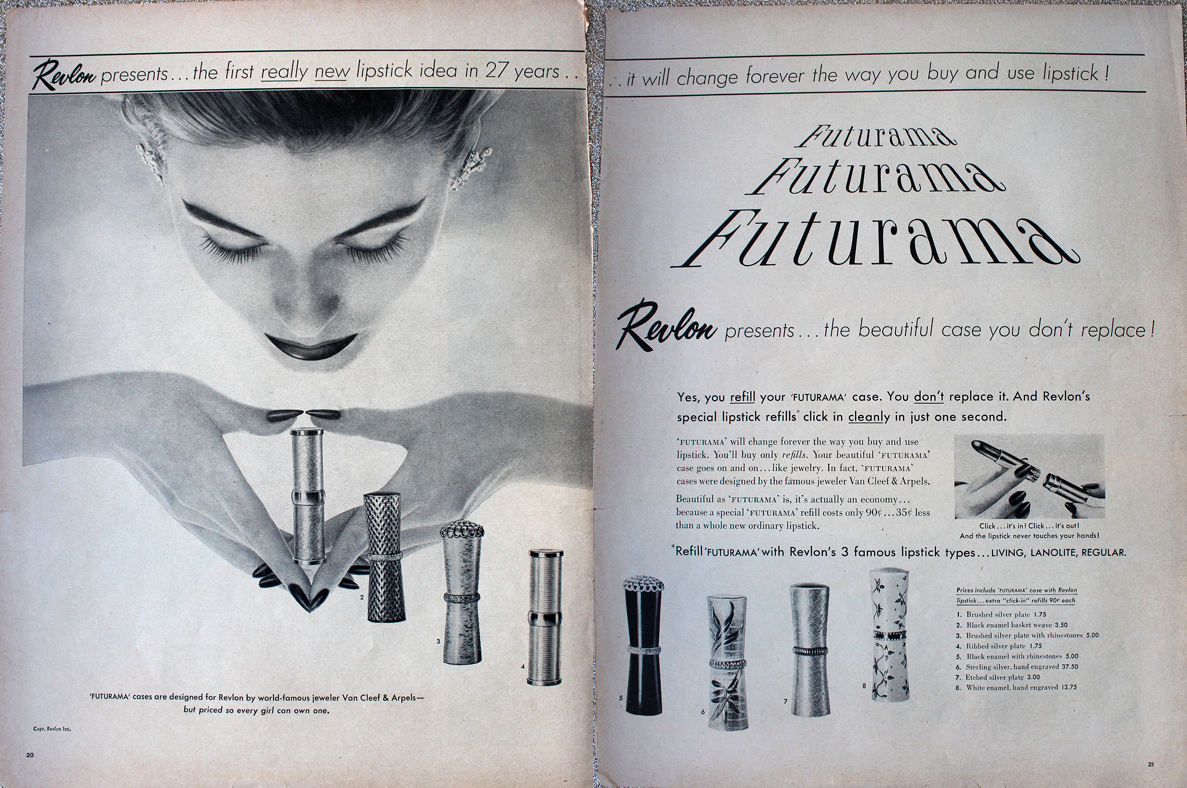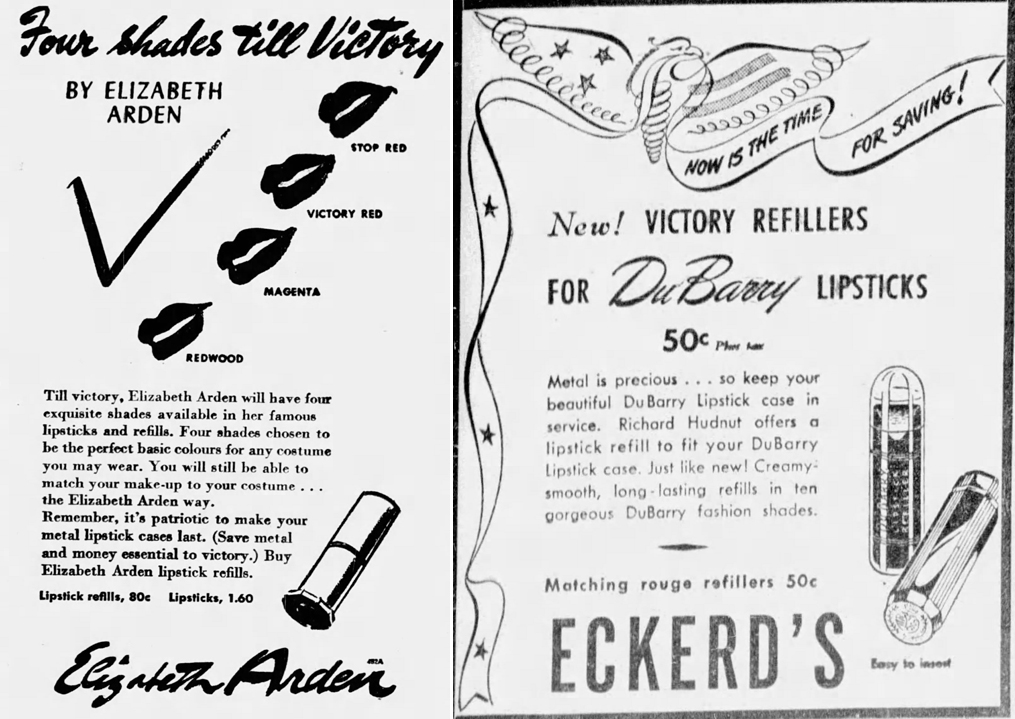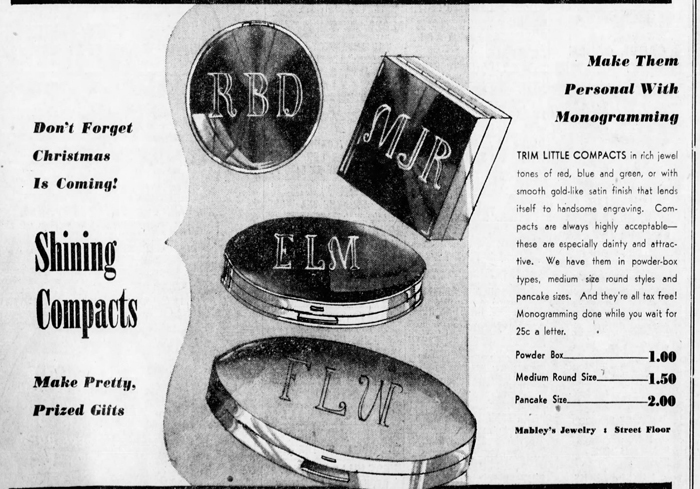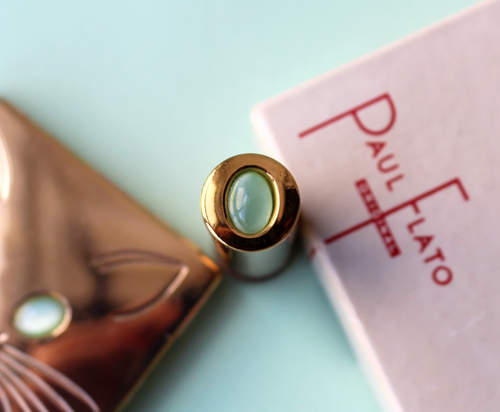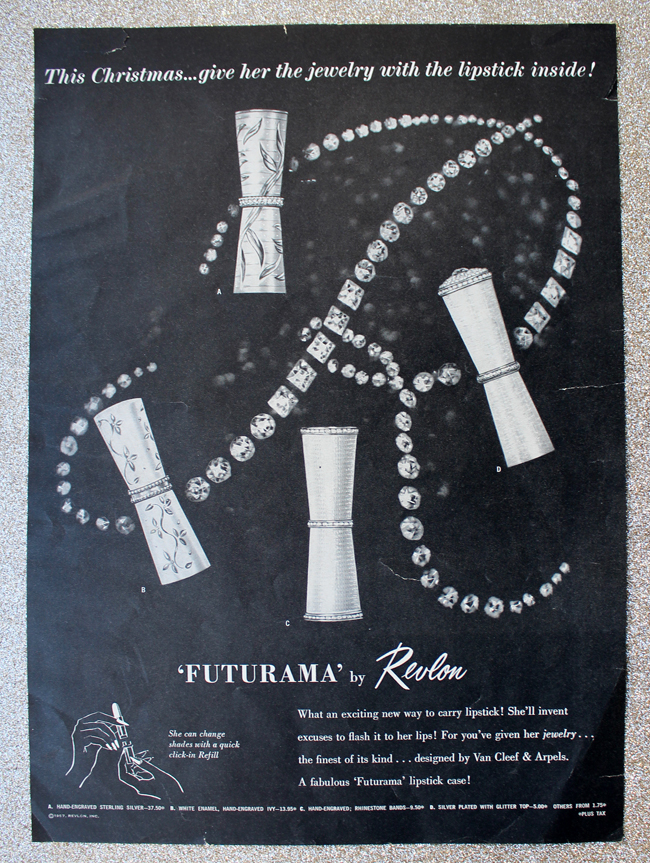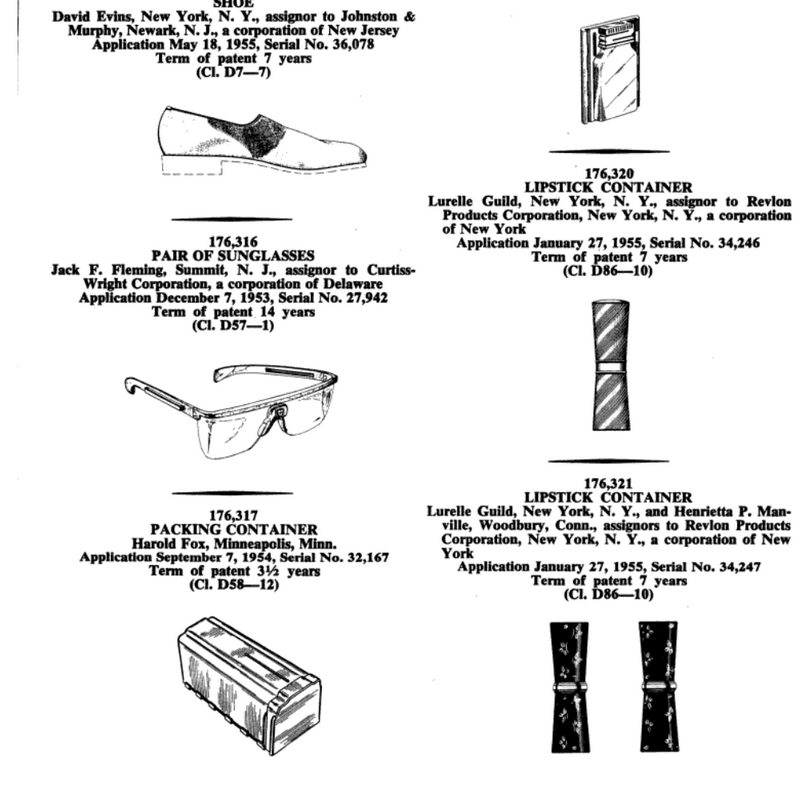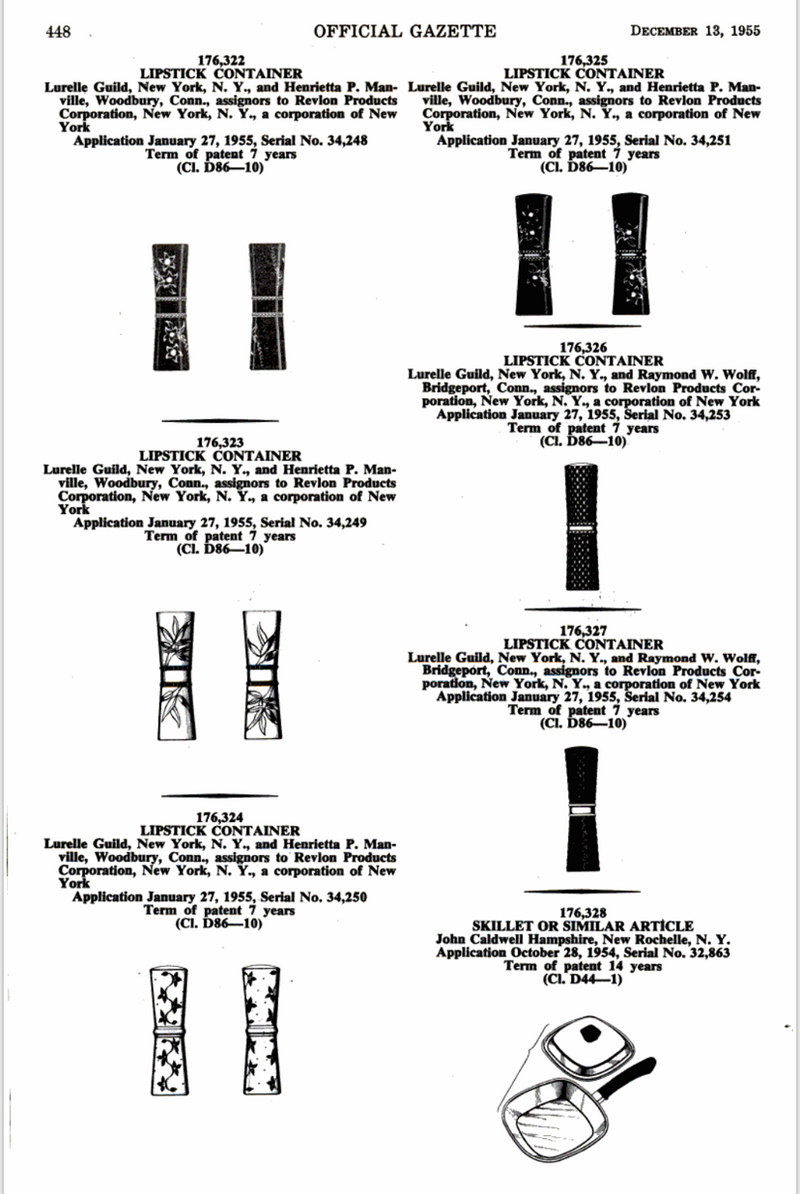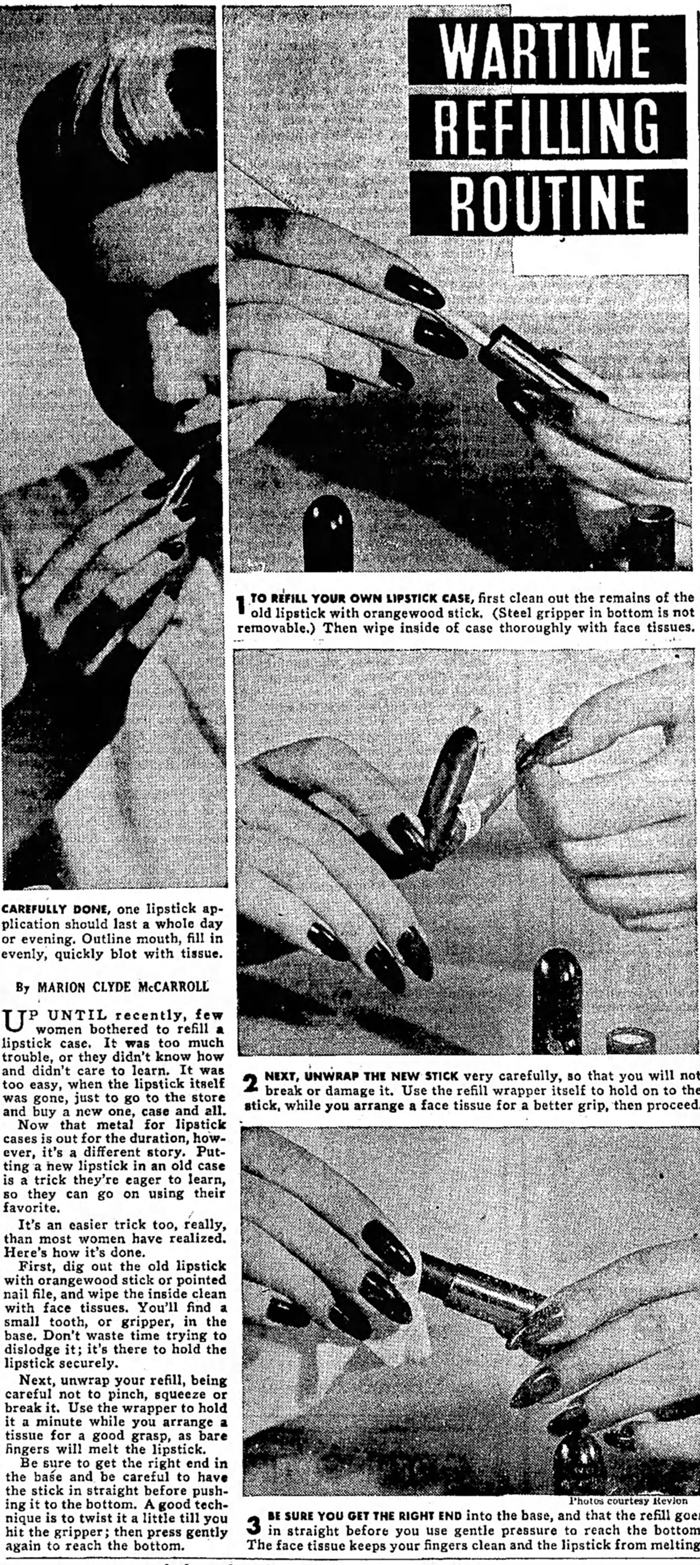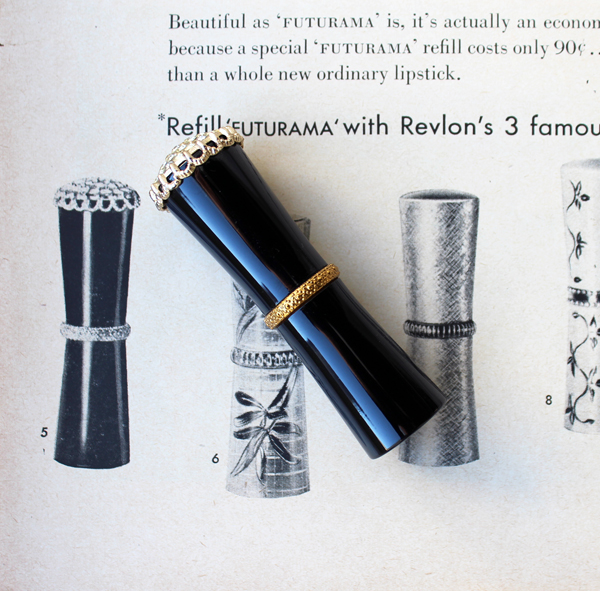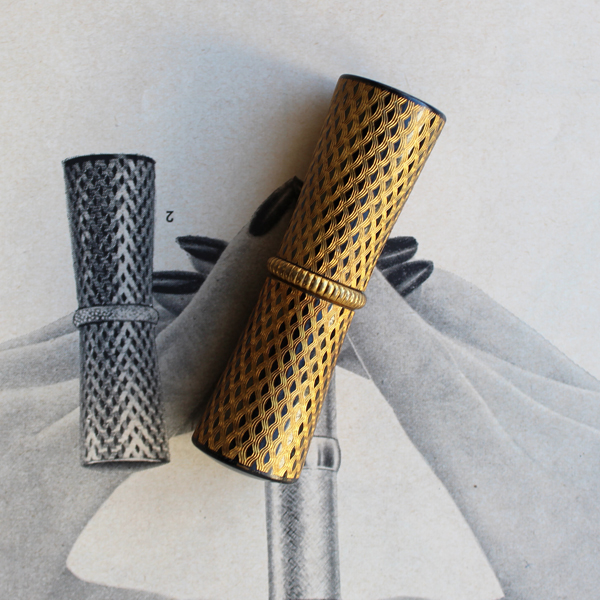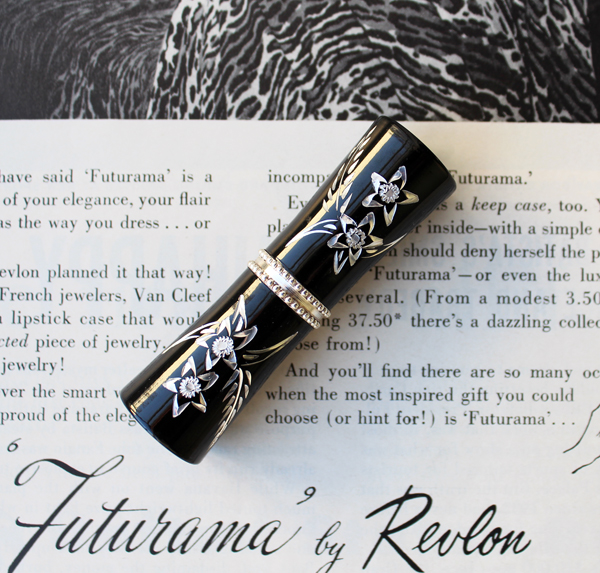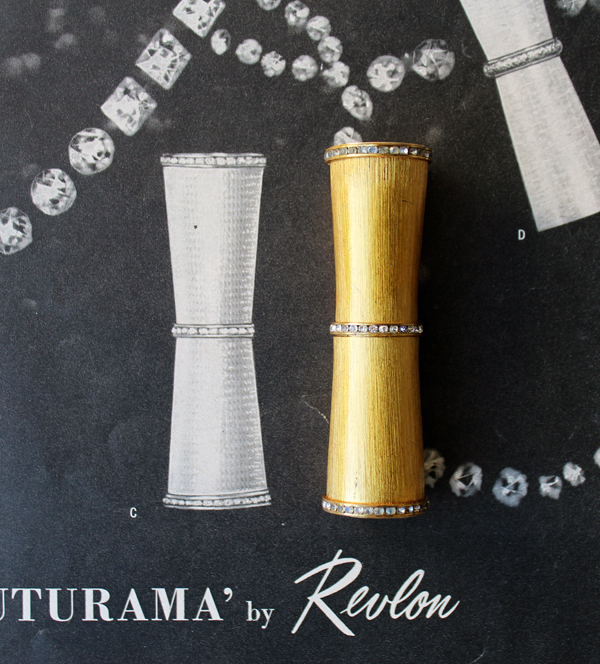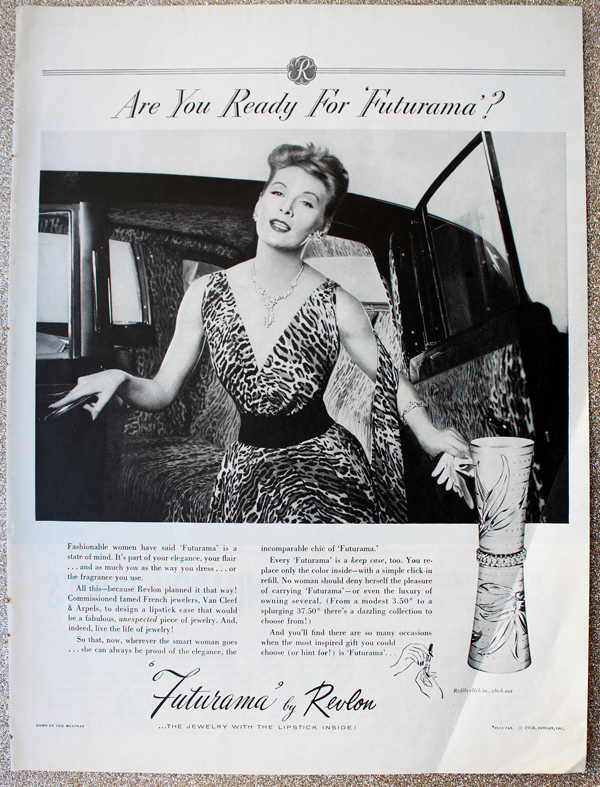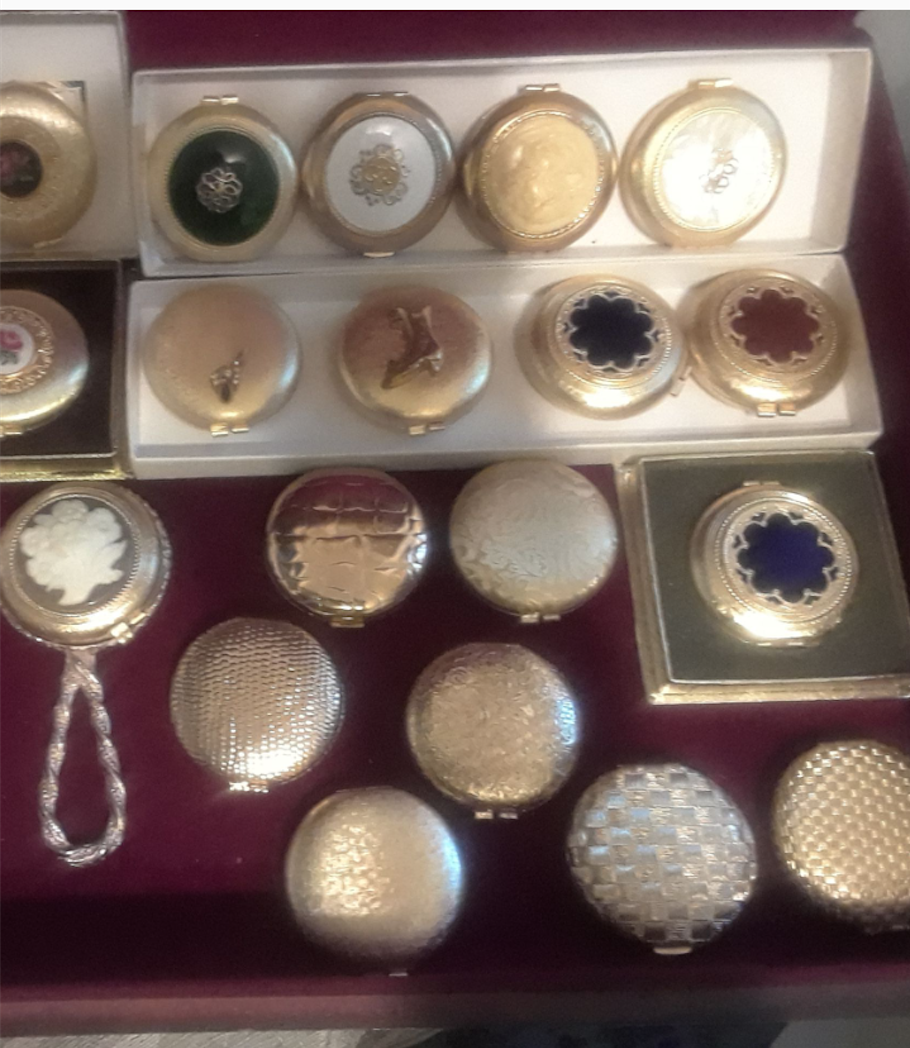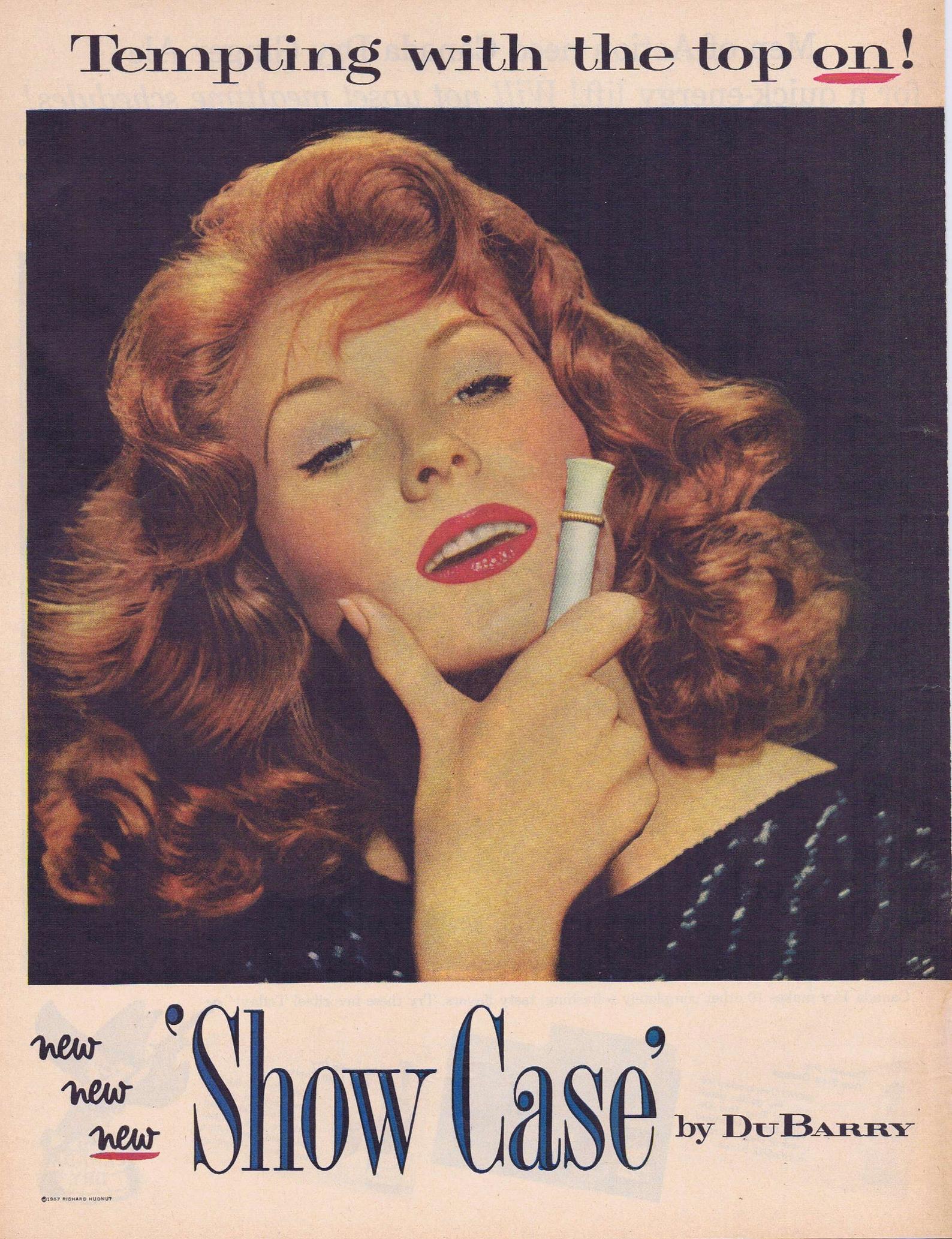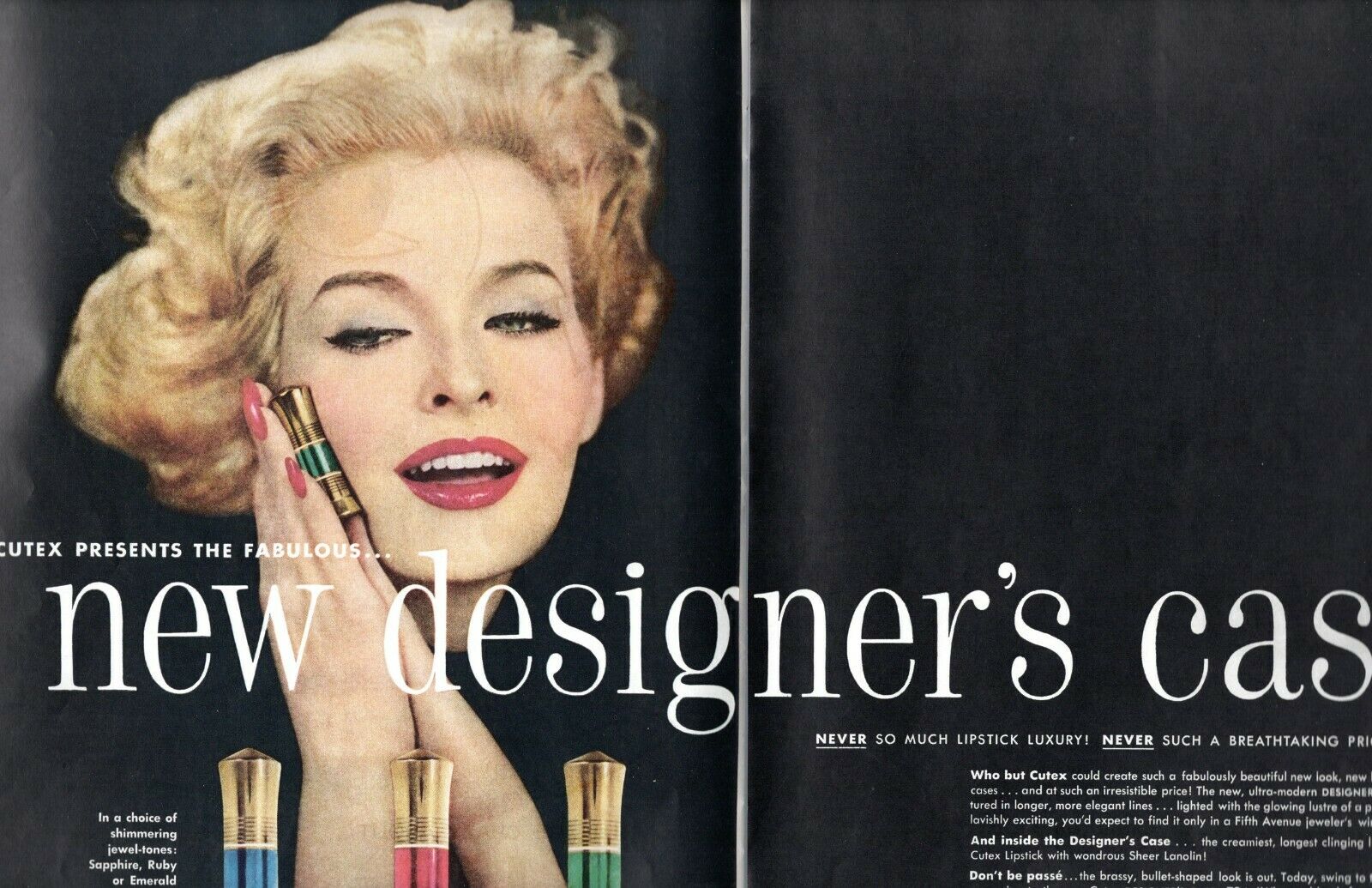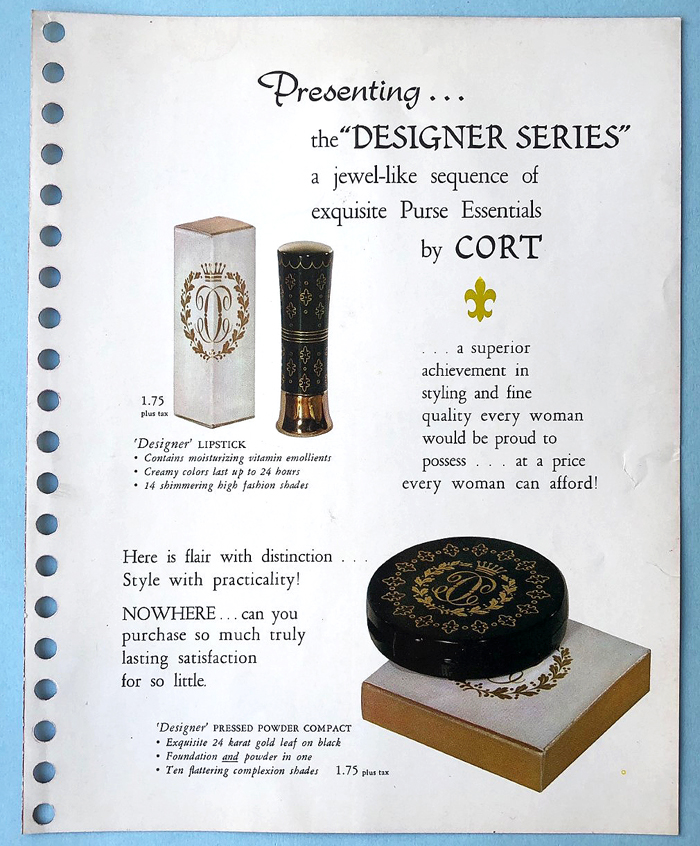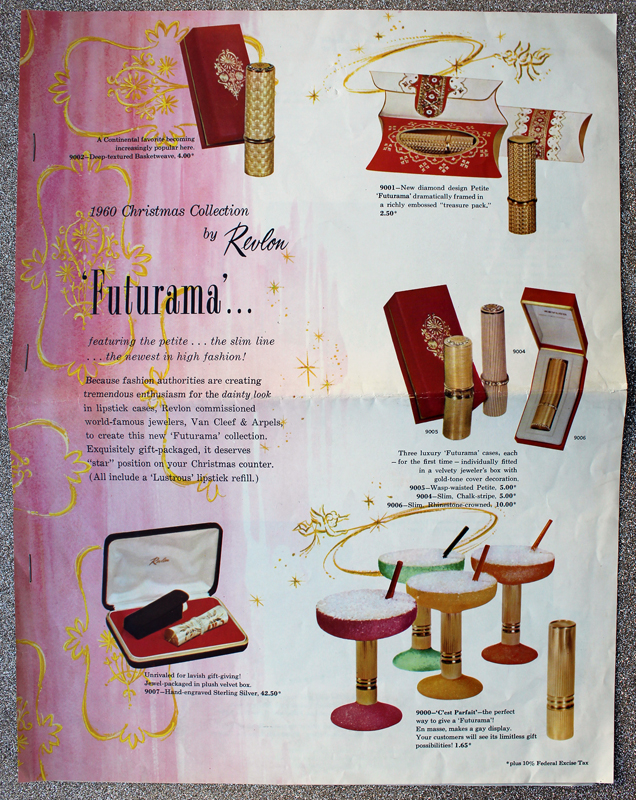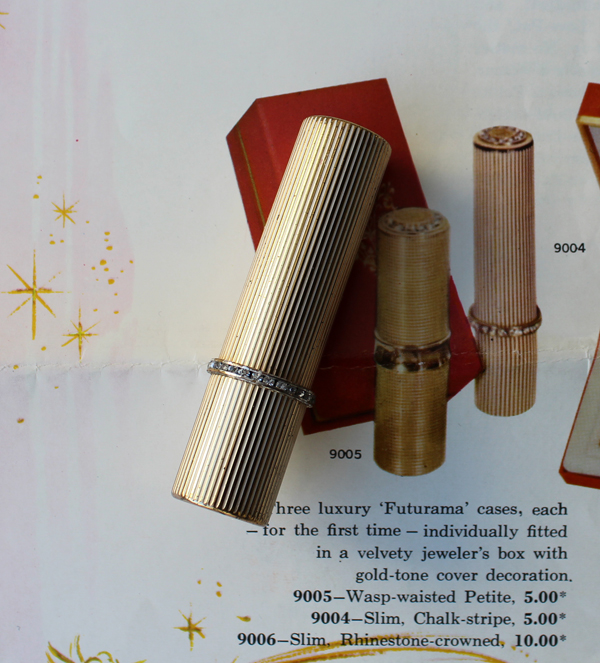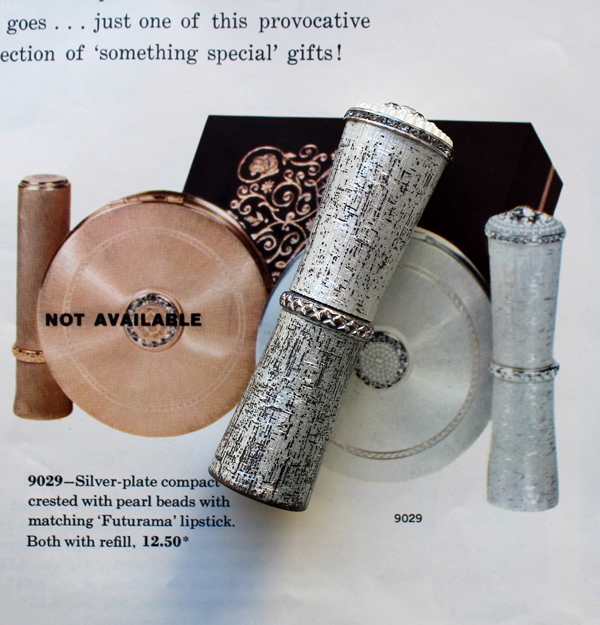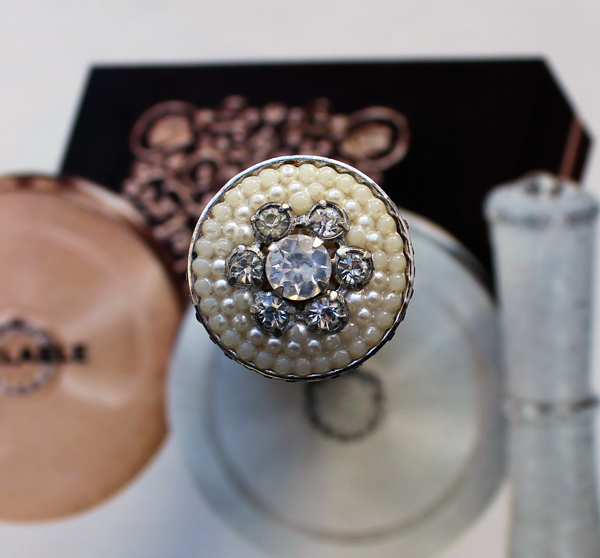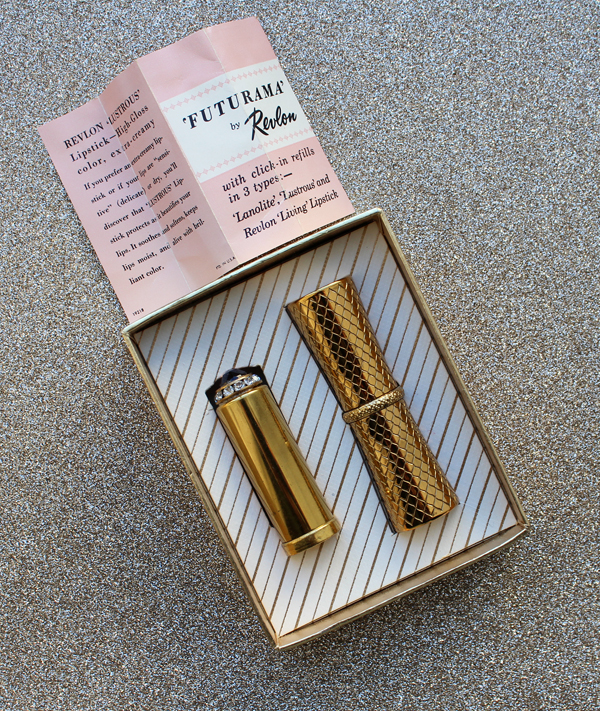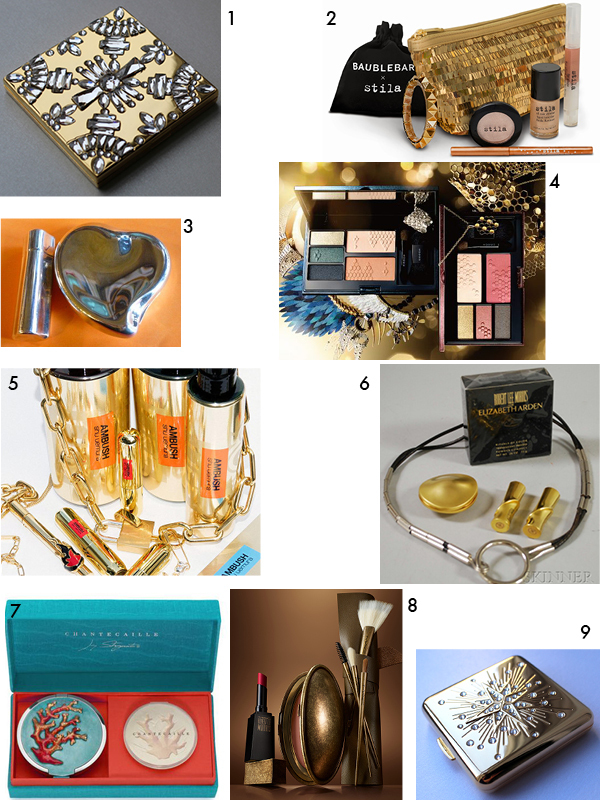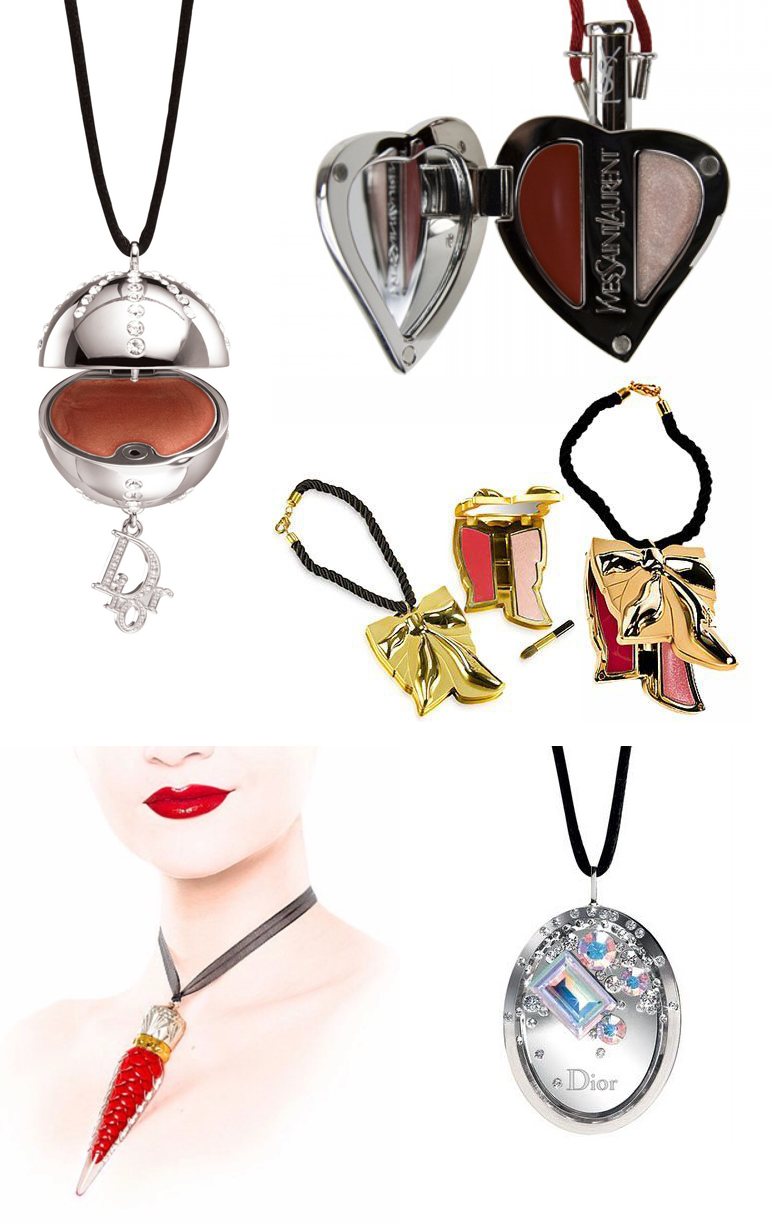"I want a case that glows with fashion. That has such fashion magic it transmits right through the lipstick and onto the faces of women. Makes them feel the beauty touching their lips." – Charles Revson, January 13, 1954.
I know, more vintage Revlon lipsticks. But I promise it's very interesting! There didn't seem to be a comprehensive history of Revlon's Futurama line so I thought I'd take a stab at it. Futurama was a collection of refillable lipstick cases designed by famed jewelers Van Cleef and Arpels for Revlon. The line was introduced in 1955 with much fanfare, especially its debut on the popular game show the $64,000 Question. But how did the collaboration between Revlon and Van Cleef happen? Who was responsible for the design? What is Futurama's significance in makeup history? I can't say I have answers to all of these questions, but I'll do my best.
First, a quick background. Refillable lipsticks had been on the market since the 1920s and became more widespread in the '40s as a way to save metal during wartime. Every last scrap was needed; the country couldn't afford to have women wasting a used lipstick tube.
The concept of makeup-as-jewelry has a longer history, with "etuis" produced in the 1700s. At the turn of the 20th century artisans were creating pendants and bracelets that held powder and lip color, and by the 1920s high-end jewelers were producing vanity cases made out of precious materials. In 1933 Van Cleef and Arpels invented and patented the minaudière, a new variation of the portable vanity case.1
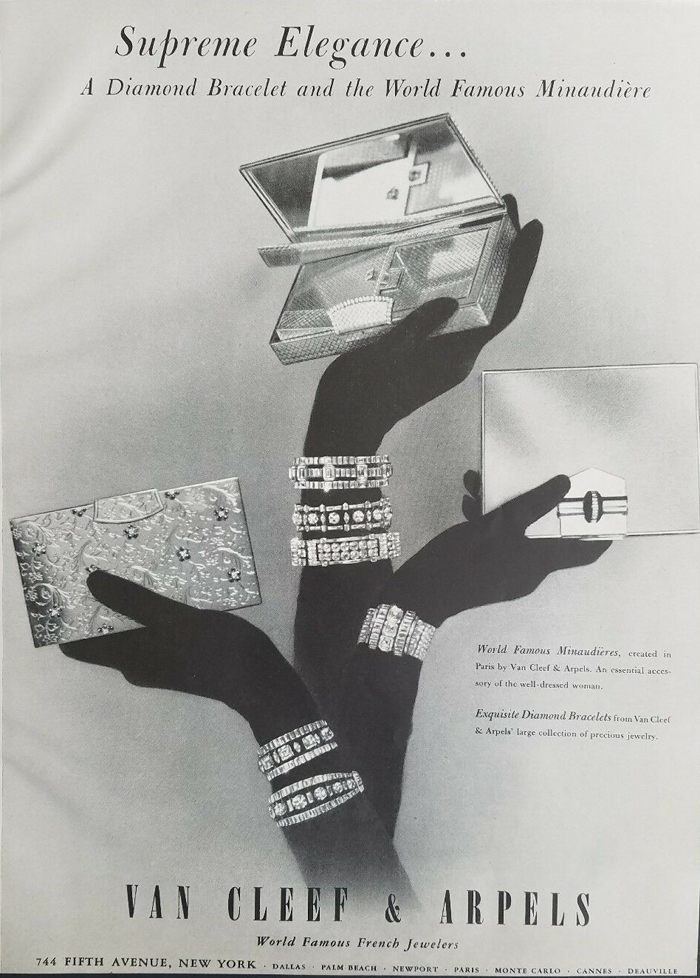 (image from ebay)
(image from ebay)
The notion of makeup as an additional accessory was reinforced by the fact that many compacts were sold in jewelry stores in addition to the jewelry section at department stores, with custom engraving and monogramming available.
Jewelry designers Ciner and Paul Flato also had their own compact and lipstick combinations in the late '40s and early '50s.
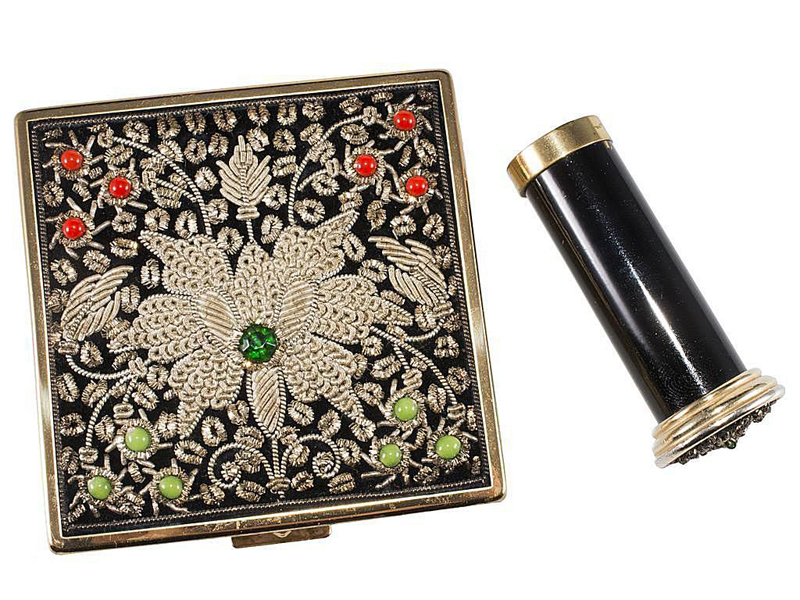 (image from thesprucecrafts.com)
(image from thesprucecrafts.com)
By and large, compacts and lipstick cases were already perceived as another item of jewelry thanks to companies like Van Cleef and Arpels leading the way. So what was new and special about Revlon's Futurama cases?
There were two key factors that Revlon advertised as the differentiators: design and price point. The concept for the design is a fascinating story. As he explains in the book Business Secrets That Changed Our Lives, Revson was inspired by a business trip to Paris. “The candlelit room, the elegant service, the fine furnishings bespoke good taste and an appreciation of beauty. Next to me sat a chic and lovely woman. What interested me most about my dinner partner was not her beauty but a small object she had taken out of her purse. My eyes returned to it again and again, until finally, with an amused smile, she handed it to me saying, ‘I would not have expected an American man to be so interested in a lipstick.’ The beauty of the case, hand-engraved and diamond-bedecked, was one outstanding feature. What really caught my eye, though, was that the lipstick could be removed with a single click-in, click-out action in just one section. And because the lipstick was contained in its own cylinder, removal of it was not only easy, but smudge-proof. My dinner partner's remark kept goading me-‘I would not have expected an American man to be so interested in a lipstick.’ Of course not! All that an American man ever saw was one of those undistinguished brass bullets!”2 Revson took a similar case back to the U.S. and less than a month later, on January 13, 1954, summoned Earl F. Copp into his office. Copp was Chief Operation Officer for Risdon Manufacturing Company, which had been making Revlon’s cases since 1947. Revson explained what he had in mind: “I want a case, a refillable case. You have to make it different from this one. This is too much like the others, refillable perhaps, but not elegant enough. I want to see luxury, fashion, expensive jewelry. No more bullets. Can you see what I mean? I want a case that glows with fashion. That has such fashion magic it transmits right through the lipstick and onto the faces of women. Makes them feel the beauty touching their lips…I don't want just one case, but a whole line. So that women will want one for morning, one for evening, one for special occasions-all suitable for refills with whatever different colors they prefer.” While refillable lipsticks existed previously, the way Futurama was advertised suggested a totally new frontier. According to design historian Matthew Bird3, Lurelle Guild (1898-1985), a prominent industrial designer at the time, was brought on board to oversee the aesthetics of the cases. As another design scholar notes, Guild was the ideal choice to design a cutting-edge, futuristic lipstick case, as he had been responsible for other iconic '50s styles such as Electrolux's Model G vacuum, which sported "rocket-like fins".4 While the cases were being advertised in 1955, Guild filed a patent in early 1956. Grace Gilbert van Voorhis, Raymond Wolff and Henrieta Manville are also named on the patents, with Manville’s name on the “utility” patent for the inner mechanism of the case. Based on census records, Manville most likely worked with Earl Copp at Risdon Manufacturing, while Wolff may have worked in Guild’s office. As for Van Cleef’s role, it appears they signed on in name only and let Revlon deal with the designs themselves; this seems especially likely given that none of the cases really resemble anything Van Cleef was making at the time.5
The designs on their own were modern for the time, but another aspect that Revlon claimed as new was the actual refill mechanism. While they weren't quite the hardship Revlon's Futurama ads made them out to be, earlier versions of refillable lipsticks could get a little messy and took a minute or two to change as compared to Revlon's alleged 3 seconds.
Futurama's "click in, click out" was certainly less involved than wartime lipstick refill instructions!

(image from cosmeticsandskin.com)
The second aspect that set Futurama apart from previous lipsticks was that customers were made to feel as though they were getting a luxury item by a brand name at an affordable price. "Like rubies and emeralds, a really luxurious lipstick case has seemed out of reach to most women…though Revlon's new cases look loftily priced, some are a low $1.75, including lipstick. Besides which, women find Futurama a money-saver since refills only cost 90c."
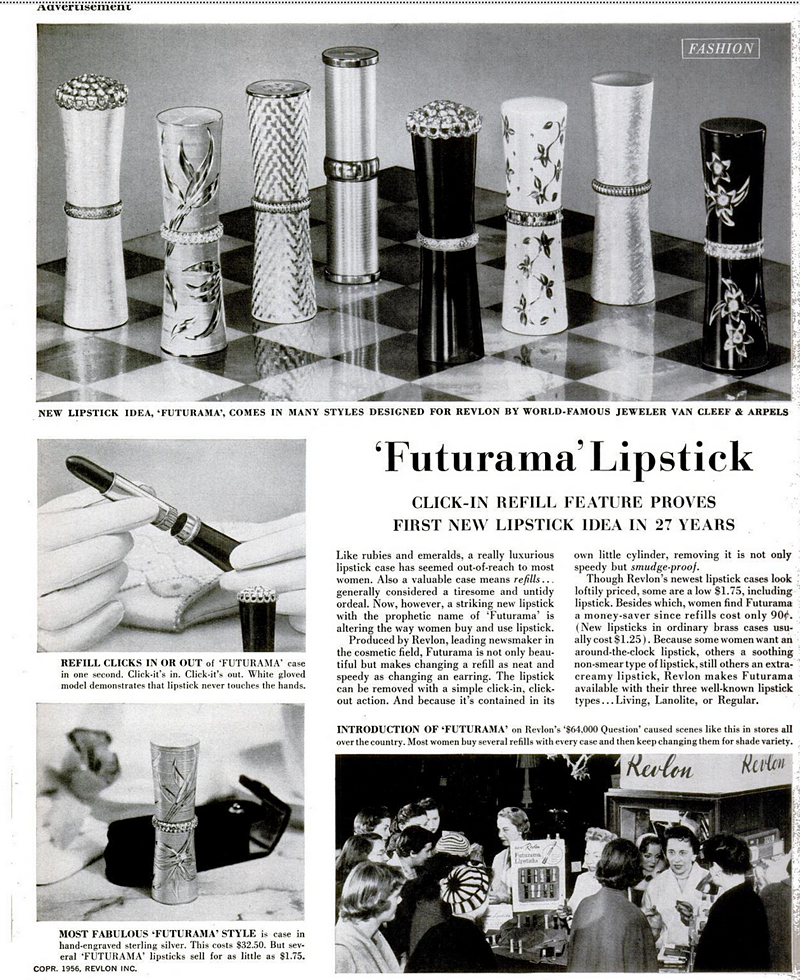 (image from Life Magazine)
(image from Life Magazine)
The cases themselves were presented as affordable, but Revlon also promoted the idea of the refillable lipstick as a cost-saving measure – once the customer "invested" money in a case, refills would be less expensive in the long term than buying a whole new lipstick.
You would think a company as large as Revlon wouldn't take a chance with their reputation by participating in price fixing, but in 1958 their shady tactic of setting refill prices was admonished by the FTC, who cracked down on them for conspiracy. The author of the fabulous Cosmetics and Skin website explains: [Futurama] went on sale in 1955 after Revlon acquired the Braselton lipstick patents for lipstick cartridges in 1954. Revlon then entered into an agreement with Helena Rubinstein and Merle Norman – along with a number of container manufacturers, including Scovill and Risdon – to fix the price of lipstick refills, including non-patented lipstick inserts, until they were charged by the U.S. Federal Trade Commission (FTC) with conspiracy."
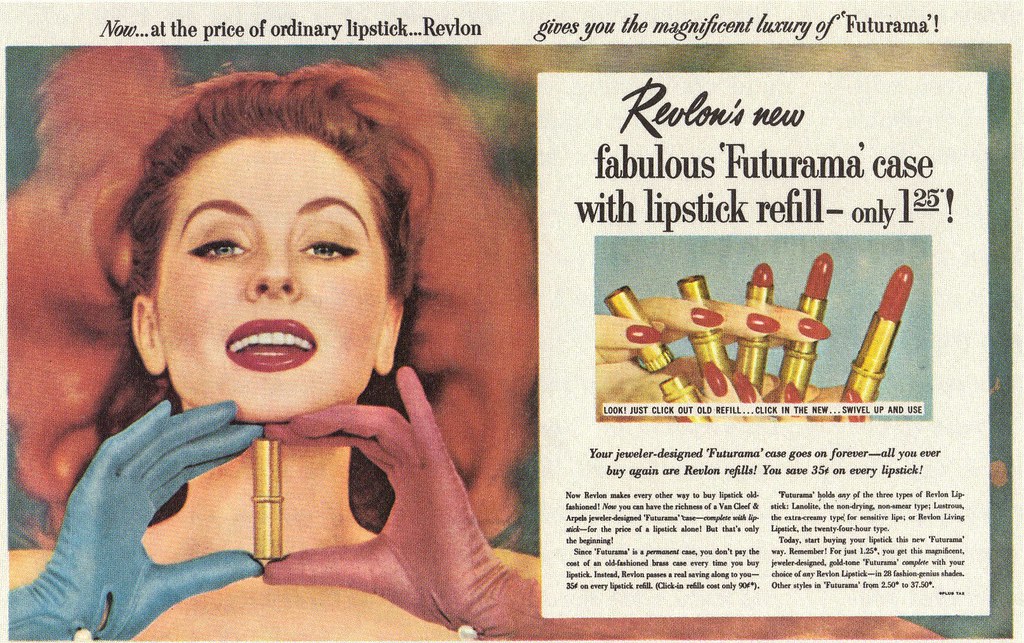 (image from saintsalvage.blogspot.com)
(image from saintsalvage.blogspot.com)
Even though it had been advertised previously, the breakout moment came when Revlon featured a commercial for Futurama on the game show The $64,000 Question, which they were sponsoring. (Revlon's sponsorship of the short-lived quiz show is a fascinating history in and of itself.) It was during this commercial that viewers could witness in real time the ease and tidiness of Futurama lipsticks, making video even more critical than print ads. As Bird notes, "YouTube allows us to watch a vintage television ad and learn that the design separated the lipstick from the case, and saved money by offering refills. The line was marketed to women, but also to husbands and children as an affordable but seemingly luxurious gift. Without this TV advertisement, the design is easy to write off as mere decoration. With this added information, the design transcends mere aesthetics to address user needs, perceived value, material use, marketing, and problem-solving. Seeing the design in action gives it a life and sophistication not evident in the brutality of an elevation view patent drawing or two-dimensional photograph."6
Overall, Futurama was presented as the wave of, well, the future. The case designs, particularly the elongated styles that were tapered in the middle and wider at the ends, were intended to reflect the modern era rather than mimic shapes of the past. Revson discusses the design selection process. "When the designs started to come in, it was an exciting and stimulating experience. Many shapes were proposed: prisms, octagons, ribbons and bows, pencils, thimbles and countless others. But the most inspired was the hourglass, a shape that four designers suggested independently. We experimented with many surface treatments, too: brocaded gold on silver, silver-plated with a gold spiral, wedding bands en circling the cylinder. With Bert Reibel, our packaging designer, I selected two basic shapes by the end of March, 1954. One group of cases, shaped like hourglasses, would retail at $2.50 or more; the other group, thimble-shaped, would be less expensive. Of all the samples submitted, only one surface treatment resembled that of expensive jewelry. We had to make arrangements with Fifth Avenue jewelers and designers, visit art museums and study color photographs of good-looking jewelry from the archives. Almost every major jewelry shop in Manhattan was visited, to study expensive, hand-designed compacts and cases. But we were still little closer to our goal. During the next eight months, we made up many thousands of designs and some five hundred actual models, each with a different surface or slightly modified shape. Parts were interchange able, so we could produce still different combinations. We invented our own special language: 'belts,' 'skirts,' 'balances,' 'waistlines.' Which 'belt' looked best with which 'skirt'? Which 'waistline' went best with which 'collar'? It got to be a joke that I was often awake all night worrying about a dimension of one-sixteenth of an inch. And it was true! The search for new surface treatments inevitably brought us face to face with the limitations of machinery. I had become intrigued by one finish we found on expensive compacts-'Florentine' by name-which was a texture of minute, finely etched lines. In 1954 no case manufacturer had the facilities or know how to produce it in volume…[Copp] finally, after long weeks of experimentation, had devised belts and grinding wheels that would simulate the 'Florentine' finish. To produce other finishes, he had to dispatch engineers to Switzerland and Italy before he could locate and buy the only turning machines on earth that could do a mass production job."
You'll notice there are very few scratches on this black case, which was the result of Revson's insistence that all the finishes should last at least 2 years before showing significant wear. "Two coats of high-bake vinyl lacquer" did the trick. The longevity of the pavé settings on the tops of some of the cases was also difficult to ensure.
After nearly a year of design work, Revlon began working on the marketing, with Vice President Kay Daly (who had previously came up with the questions for Revlon's iconic Fire and Ice quiz) leading the way. "Early attempts missed the boat because they emphasized the fashion element, but did not adequately sell the 'refillable' idea. The most frustrating task [Daly] undertook was the selection of a name for the cases. Hundreds were suggested, considered and rejected. l could not agree-no one could agree-on any of them. Finally, she hit on Futurama. To my mind, this suitably brought home the newness, the excitement, the fashionableness of the product…A market research organization reported that Futurama 'is not a good name. It is too masculine. It sounds too much like General Motors.'…In the end, I had to make the decision. There was, of course, only one way to look at it: from the viewpoint of the American woman herself. I decided to rely on my original reaction that the name was good, and that it would appeal to the consumer I knew best." The name was rumored to be taken from the Futurama exhibition at the 1939 New York World's Fair and speaks to the post-World War II futurist trend in American design and technology. Additionally, Revlon declared both the economic practicality and new designs to be the most cutting-edge ideas in cosmetics, and any modern woman should want to join the party. "Are you ready for Futurama?" asks this 1958 ad.
If you weren't on board with Futurama, you were getting left behind; the ads not so subtly implied that women who didn't purchase Revlon's latest offering were unfashionable and stuck in the past. According to one commercial, "The days of old-fashioned, un-style-conscious mothers are about as out-moded as old-fashioned brass lipstick…modern mothers may be old-fashioned on the inside, but they want to be the picture of glamour and style on the outside."
By late 1957 Futurama had expanded to compacts, which were also refillable. While not as notable as the lipsticks, the compacts solidified Futurama as the most recognized line for Revlon at the time. Something that is of note, however, is the fact that Andy Warhol may have been involved in the design of at least one of the compacts. A while ago a private collector sent me some photos and surmised that Warhol might have been responsible for a Revlon Futurama compact featuring his drawing of an early 1900s style shoe. This is what she had to say: "I emailed Van Cleef and Arpels about who exactly designed these lovely creations and I actually got a call from a representative wanting to find out information on a specific compact I have that she called 'the Warhol Boot'…It was supposedly one of 5 display/prototypes that went missing between 1959 and 1961. It was designed by Andy Warhol but rejected by Revson because it didn't fit the 'mood' of the collection." If this is true, what an amazing find! Take a gander at the second compact from the left in the second row.
I reached out to another collector whose father worked for Revlon, but she was unable to find any definitive proof that Warhol designed the compact. Still, it resembles his shoe illustrations.
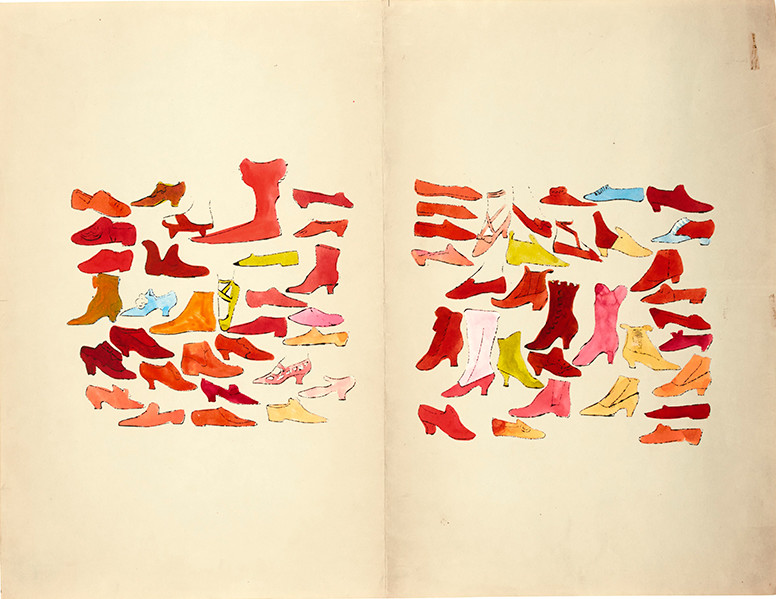
(image from artnet.com)
Getting back to the lipsticks, Revlon's competitors were just as cutthroat as they would be today in that several companies released jewelry-inspired cases of their own. Take, for example, DuBarry's Showcase. Model Suzy Parker was featured in DuBarry's ads – an unusual move given her appearance in Futurama ads. What is not surprising that the company doing this is DuBarry, who you might remember would go on to shamelessly rip off Revlon's Fire & Ice lipstick with their Snowball of Fire shade in 1959.
 (image by feldenchrist on flickriver.com)
(image by feldenchrist on flickriver.com)
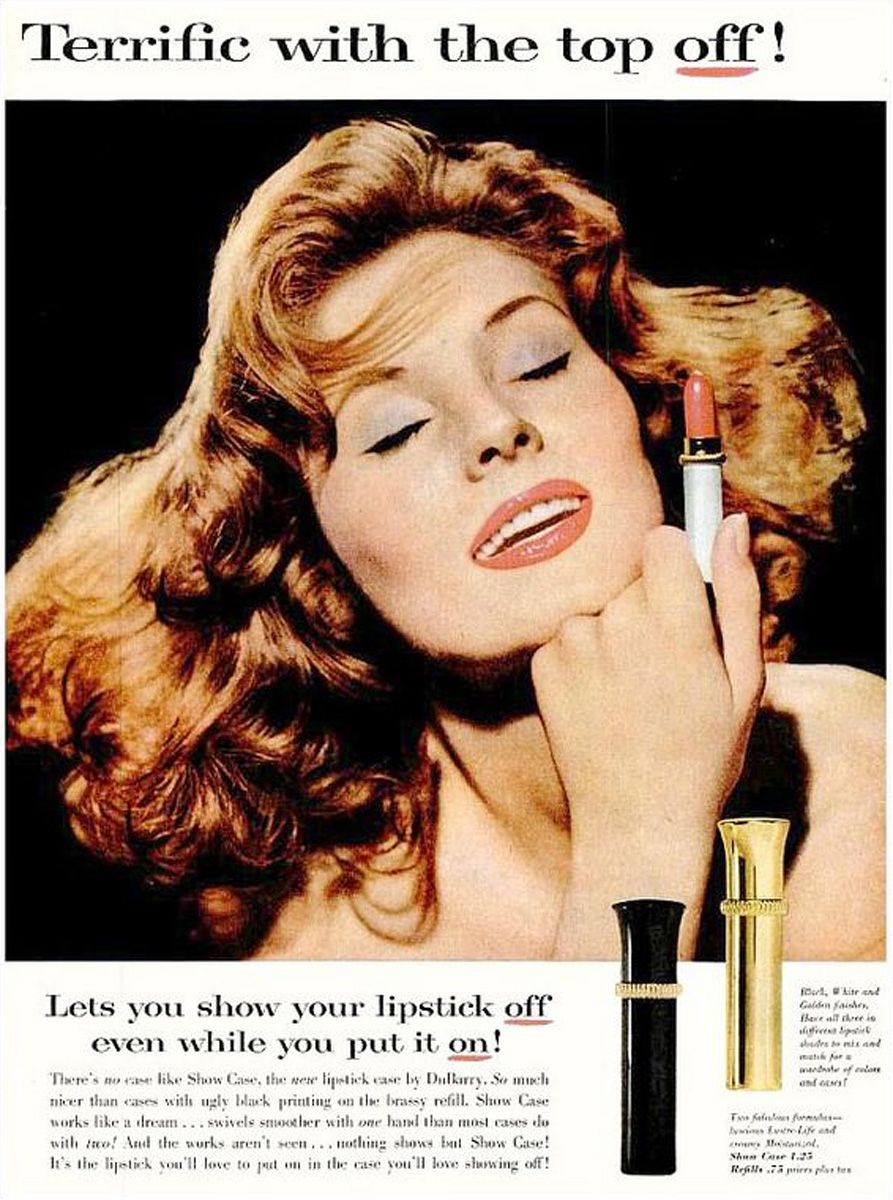 (images from pinterest)
(images from pinterest)
Cutex was even more blatant in their plagiarism (but at least they used a different model, Sara Thom). In 1958 the company introduced their "designer's cases" which were apparently similar to something one would find in a "Fifth Avenue jeweler's window". The notion of previous lipstick case styles as being "passé" was also copied from Revlon. I'm not sure these were refillable, but they were definitely lower priced than Revlon's refills.
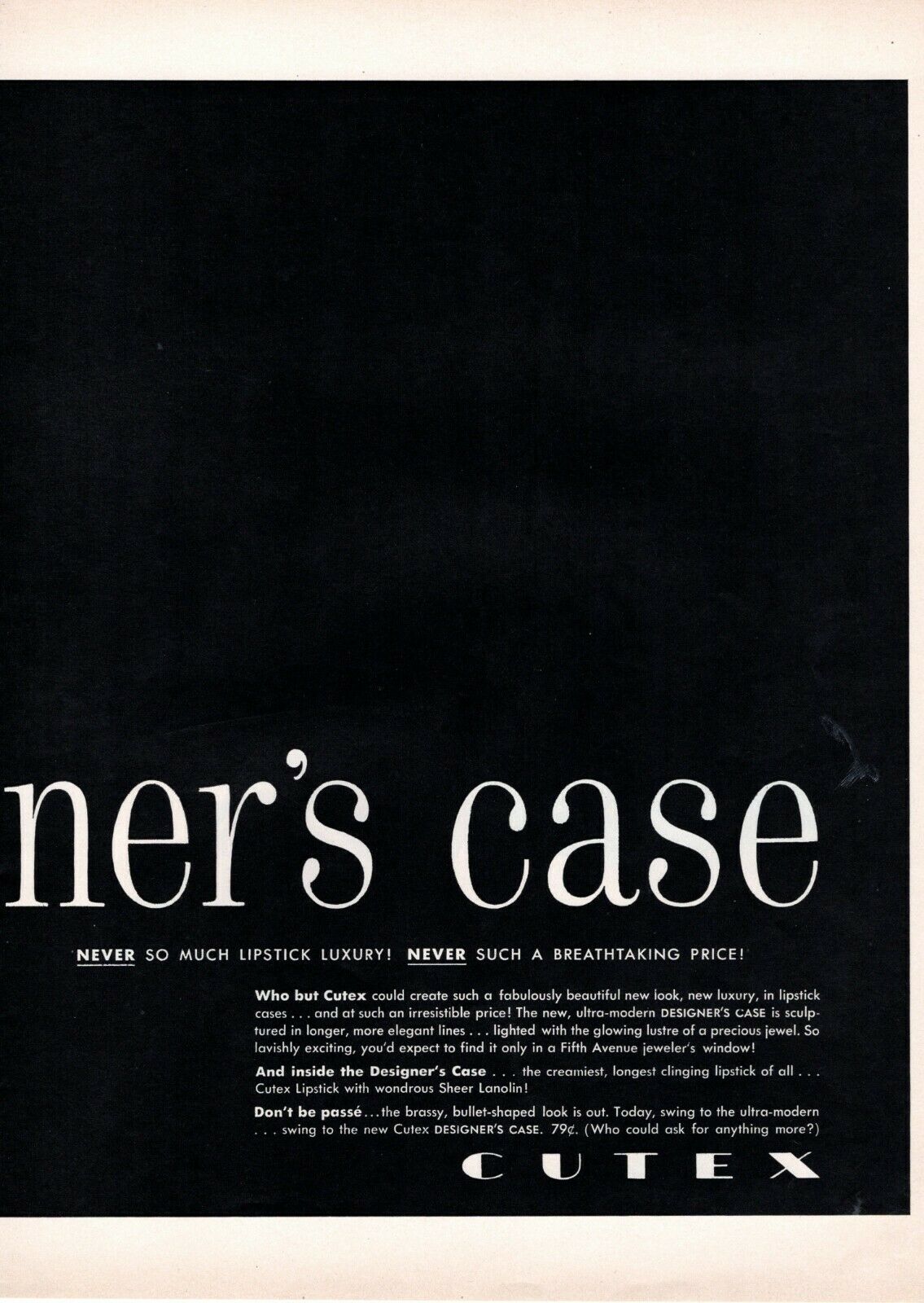 (images from ebay)
(images from ebay)
There was also this Avon clone making a series of "jewel-like" cases at a price "every woman can afford."
Can you say "knock-off"? Then as now, this sort of plagiarism was rampant in the industry (more on that in another post). To my knowledge none of these brands had partnerships with actual jewelry companies the way Revlon did, but they were definitely capitalizing on the makeup-as-inexpensive-jewelry concept.
As of December 1960 Futurama was still being heavily promoted by Revlon. A vast array of designs had joined the original lineup, while the older styles received elaborate outer packaging to suit any occasion.
Something that I have not been able to confirm is the numbering of the cases. This one is listed in the ad as 9029, but engraved on the bottom is 587. I believe the numbers on the bottoms of the Futurama cases correspond to the lipstick shades, not the case model, but I can't be certain.
Futurama was phased out by the mid-1960s, but its influence is alive and well today. Many makeup companies have collaborated with jewelry designers either for their permanent collection or limited edition collections. The idea of owning luxurious yet modestly priced jewels via makeup persists. As with the beauty lines of fashion houses or artist collaborations, if one cannot afford vintage jewelry or an original piece by a high-end designer/artist, makeup allows the customer to get a taste of the real deal. Here's a quick list of some of the more memorable makeup/jewelry collaborations. I'm also keeping my eyes peeled for one of these Cutex lipstick bracelets, which were sold around 1955-1958.
- Lulu Frost for Bobbi Brown, holiday 2013
- Bauble Bar x Stila, holiday 2014
- Elsa Peretti for Halson, late 1970s
- Ayaka Nishi for Suqqu, holiday 2016
- Ambush for Shu Uemura, spring 2017
- Robert Lee Morris for Elizabeth Arden, 1992
- Jay Strongwater for Chantecaille, spring 2007
- Robert Lee Morris for MAC, fall (see also MAC's collaborations with Jade Jagger and Bao Bao Wan)
- Monica Rich Kosann for Estée Lauder, holiday 2016 (Kosann continues to design Estée's holiday compact line.)
Some high-end lines go the Cutex route by creating makeup that can actually be worn as jewelry. Dior, YSL and Louboutin have all released lip products in pendant form.
Refillable lipsticks with outer cases meant not only to last but also displayed are thriving in 2020, given the increasing demand for sustainable packaging. The most recently unveiled jewelry-inspired line, and probably the one most similar to Futurama besides Guerlain's Rouge G, comes from fashion designer Carolina Herrera. “We wanted to give women an opportunity to wear their makeup like a piece of fabulous jewelry," Herrera stated. The entire line is refillable and offers customization options in the form of detachable charms and a variety of case styles.
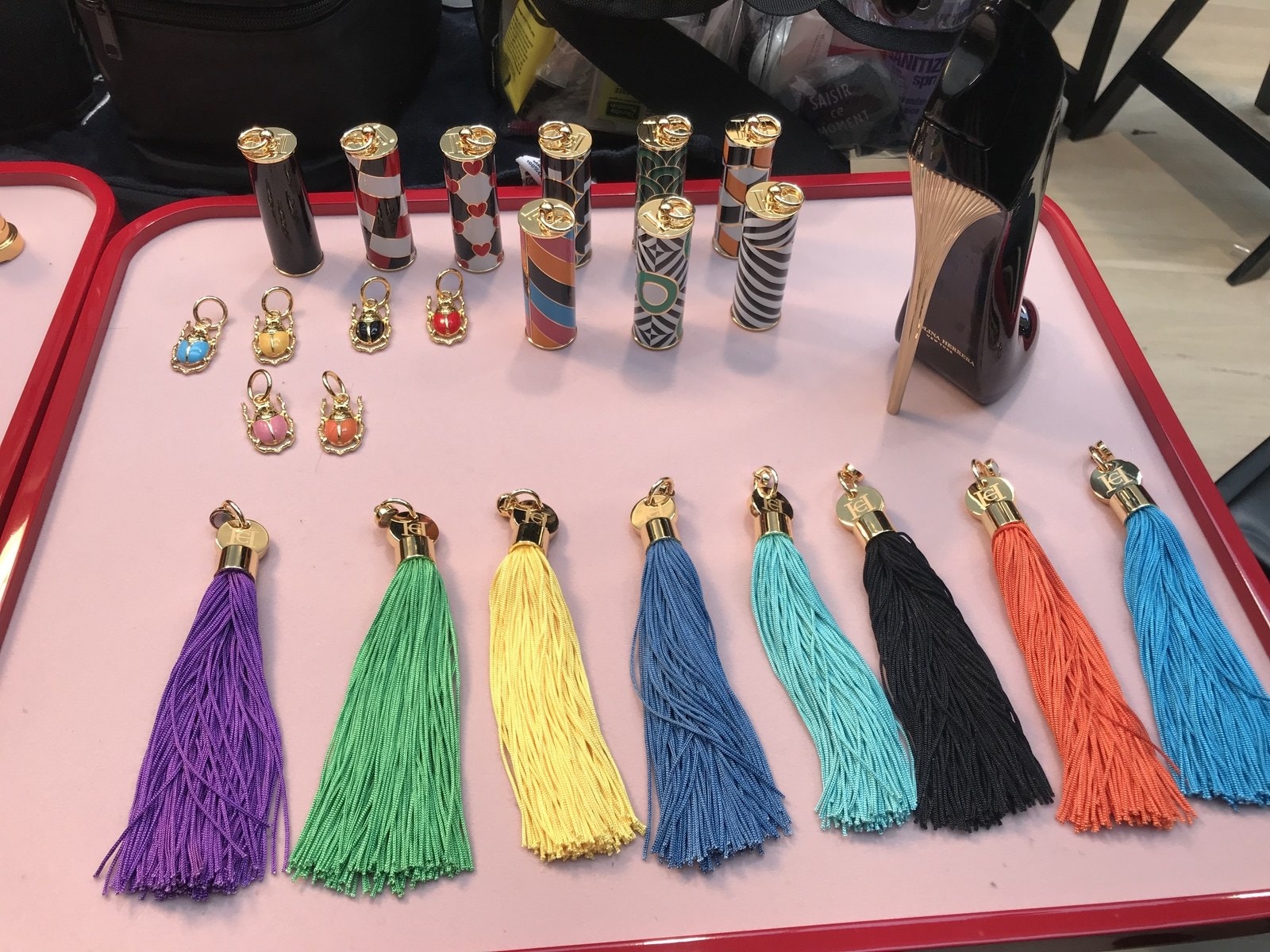 (image from vogue.com)
(image from vogue.com)
Would all of these examples have existed without Revlon Futurama? Sure, but Revlon did a lot of the heavy lifting. Despite the exaggerated tone of the ads, Futurama was groundbreaking in that it popularized the notion of attainable luxury within the cosmetics arena and simplified the lipstick refill process. The cases also serve as a prime example of the futuristic flavor of 1950s American design. These factors make Futurama a significant cultural touchstone on par with Revlon's previous Fire & Ice campaign. At the very least, Futurama represents several key developments in cosmetics advertising and packaging that helped lay the groundwork for today's beauty trends and shape consumer tastes.
Which Futurama design is your favorite? Would you like to see a history of refillable lipsticks or an exhibition expanding on the makeup-as-jewelry concept? I have to say I'd be curious to see what Revlon would come up with if they did another collab with Van Cleef…it would be awesome if Futurama 2.0 incorporated Van Cleef's signature Alhambra motif.
1 Give yourself a crash course in learning the lingo for various makeup cases and the differences between them. Noelle Soren's website is a treasure trove of knowledge!
2Revson elaborates on existing cases. "For a long time it had been bothering me that American women-so alert in many ways-had been content with that old smooth brass cylinder . It had no distinctive shape, color, finish or design. It looked like a cartridge case. They would buy them and discard them when they were used up, and then buy another…A number of cosmetics manufacturers had for years tried to make cases more distinctive. We had played around with the idea at Revlon. But all that any of us ever came up· with was an other version of the cartridge case. For one thing, all case manufacturers, including Risdon, had the same kinds of machines, with the same old limitations." ("The Matter of Beauty: The Development of the Futurama Lipstick Case" in Business Secrets that Changed Our Lives, edited by Milton Shepard (1964), p. 294.
3 Matthew Bird, "Using Digital Tools to Work Around the Canon" in Design History Beyond the Canon, edited by Jennifer Kaufman-Buhler, Victoria Rose Pass, and Christopher S. Wilson (2018), p.114-117.
4 Through this paper I discovered that there are two folders worth of Revlon correspondence and sketches for lipsticks in the official Lurelle Guild papers, which are housed at Syracuse University. I have requested electronic copies of these but obviously since the library is closed due to the coronavirus I will have to wait to receive them and see if they shed any more light on the Futurama design process. I'm also still trying to figure out whether Van Cleef designed this beautiful jeweled case, as Pinterest is literally the only place I've ever seen it.
5 There is an ad in the January 1956 issue of Reader's Digest that mentions Charles Revson "commissioning" Van Cleef and Arpels to design the Futurama line. Google, however, will not let me see the entire ad, and I've purchased 2 copies of that particular edition of Reader's Digest to no avail – there was no Revlon ad in either of them. Either Google has the date wrong or, as one eBay seller noted, the ads differed between Reader's Digest even if they were the same exact editions (i.e. same month and year.) If anyone knows how to access Reader's Digest in full online, please let me know!
6 Matthew Bird, "Using Digital Tools to Work Around the Canon" in Design History Beyond the Canon, edited by Jennifer Kaufman-Buhler, Victoria Rose Pass, and Christopher S. Wilson (2018), p.114.


